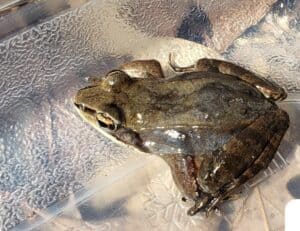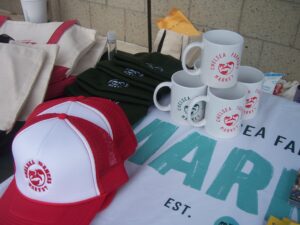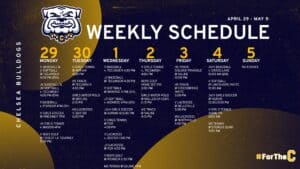
Story and Photos by Master Naturalist Doug Jackson
Frogs?
Seriously?
Although they are not exactly the first thing we think of in the middle of a frozen winter, there is one species of Michigan frogs that has something somewhat miraculous going on with it this season.
In spring and summer, we frequently encounter our web-footed friends as they croak and splash in ponds and along lakeshores. Michigan has 13 frog species, 10 of which can be found around Chelsea.
While the mink frog, Cope’s gray tree frog, and the Fowler’s toad are found elsewhere in the state, here we can find the American toad, bull frog, green frog, northern leopard frog, pickerel frog, eastern gray tree frog, western chorus frog, northern spring peeper, Blanchard’s cricket frog – a species discovered by our local and late U-M herpetologist, Frank Blanchard, and the star of this article – the wood frog, rana sylvatica.

Wood frogs are a medium sized frog, roughly 2” in length, light brown with a distinctive dark mask over their eyes. They are not to be confused with another masked frog, the western chorus frog, which is much smaller and lacks the light-colored dorsal ridges that run down either side of the wood frog’s back.
Frogs are amphibians. Amphibians are a class of animals that live both on land and water and are smooth and soft bodied. Like their scaly reptilian cousins, amphibians are ectothermic, meaning that they are cold-blooded and cannot regulate their own body temperatures.
However, unlike reptiles, amphibians go through a lifecycle process called metamorphosis. Through metamorphosis, the animal undergoes radical changes in its body as it matures. This trait is shared with many insects as well.
All amphibians start their life as embryos in eggs. After mating, the mother wood frogs spawn in quiet ponds, preferably woodland vernal pools where no fish live to prey upon the eggs and young. As many as 3,000 eggs are clumped together in a large gelatinous glob that can be found floating near the water’s surface.

After gestating for a month or so, the eggs hatch out tiny dark tadpoles composed of just a head-like oval body and tail. Just as fish do, tadpoles have gills to breathe water with as they grow up eating vegetation underwater.
An interesting study has found that wood frog tadpoles are the only known amphibian species that can recognize their own family. It was discovered through careful markings that wood frog tadpoles tend to seek out members of their own family and stay grouped amongst themselves. It’s not yet understood why.
As the tadpoles mature over the next couple of months, they grow larger and begin to sprout legs, first the two rear, followed with the front ones. They are morphing into froglets.
At this point, they have developed lungs in place of their gills, and need to surface to breathe air. They also stop eating vegetation and start absorbing their tails for nourishment.
Soon, they’re able to hop out on land as tiny wood frogs and begin to forage for insects. They have transformed from vegetarians to carnivores.
Throughout the summer months, the young wood frogs grow larger and venture out from their nursery pools, hopping through the woods anywhere from 100 yards to a mile away. They spend their summer lives away from water and amongst the trees, thus giving credit to their names.
As fall arrives with cooler temperatures, the wood frogs make their way back to the shores of the same pools they started from.

As winter arrives, the wood frogs prepare for their miraculous feat – hibernation. They find their hibernacula under dense leaf or wood cover. As temperatures drop below freezing, their organs begin to shut down completely, their hearts cease beating, and their bodies freeze solid. The frogs’ bodies produce large quantities of urea and glucose within their cells that help prevent their tissues from forming ice and dying while frozen. And so, they spend their winters, for all intents and purposes, as dead, frozen frog-cicles.
Alas, these frogs have not officially croaked.
Once spring arrives in March and temperatures stay above freezing, the wood frogs – in the spirit of Easter- will resurrect from their cryogenic state. They start thawing, and their hearts will start beating again. Once they’ve regained consciousness and mobility, they congregate in their pools filling the air with their quacking mating calls that, to me, sound like balloons being rubbed.
The springtime mating ritual commences, and the adults produce their new generation of wood frog spawn in our vernal pools.
Vernal pools are not only home to wood frogs, but are the nursery for many other fascinating animals, some of which live exclusively in them. We’re learning that these unassuming wetlands are vital to the ecology in and around them and deserve better understanding and conservation efforts.
You can learn more about vernal pools, their fantastic animals, and the citizen science program where you can help study and record critical data on our local pools at my free presentation Feb. 18 at 2 pm at the Eddy Discovery Center, 17030 Bush Road.
To register to attend this or other of our winter programs, please visit www.wnha.org or email [email protected].














